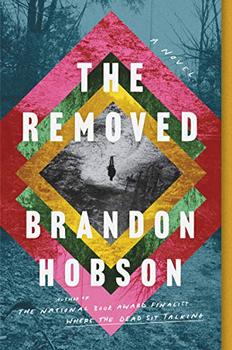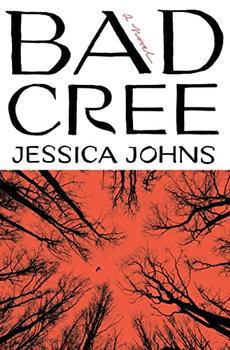Summary | Excerpt | Reviews | Beyond the book | Read-Alikes | Genres & Themes | Author Bio

Simultaneously of the moment and steeped in history, Brandon Hobson's The Removed considers the intersection of intergenerational trauma and ongoing inequity through the perspectives of a Cherokee family living in Oklahoma. They are haunted by literal apparitions, by events from the past and by the legacy of centuries of violence. But Hobson's characters also actively reject that legacy with their own agency and will to endure in a world that is indifferent, if not outright hostile, to Native lives.
The novel takes place 15 years after Maria and Ernest Echota's teenage son Ray-Ray was shot and killed by a police officer at a shopping mall. Every year, Maria and Ernest and their other two children, Sonja and Edgar, gather for a bonfire in Ray-Ray's honor on the anniversary of his death. However, the plans for this year's gathering are complicated by Ernest's worsening Alzheimer's symptoms and Edgar's estrangement. Edgar has been keeping his distance from the family since a failed attempt at an intervention to get him to stop using drugs six months before the events of the story. Meanwhile, Maria and Ernest are hosting a charismatic 12-year-old foster child named Wyatt, also Cherokee, who evokes memories of Ray-Ray. Ernest becomes convinced that Wyatt has the spirit of their dead son inside him. Maria is doubtful, but she is surprised to discover that the more time Ernest spends with Wyatt, the more his memory improves.
Through the perspectives of Edgar and Sonja, Hobson explores some of the more complex iterations of residual grief that can persist years after a tragedy like Ray-Ray's death. Maria's feelings and motivations are relatively straightforward; she is a mother missing her son and channeling her sadness into helping young people through volunteer work and fostering Wyatt. For Edgar, drugs are a coping mechanism for the unresolved survivor's guilt and hopelessness he feels related to his brother's death. After his girlfriend breaks up with him, he takes a train to a nearby town referred to only as the Darkening Land and becomes ensnared in a nefarious plot perpetrated by an old friend, all the while haunted by the literal and metaphorical ghosts that populate the novel.
Sonja is granted the most depth and complexity. While her plotline is less dramatic than Edgar's, it is the most emotionally dynamic. She develops a romantic obsession with a man named Vin who is attractive but not particularly interesting or pleasant to be around, and follows him around town while he is with his young son. It seems to be a pattern for Sonja, this desire for men who are by all appearances nothing special. By the time Vin is asking Sonja to "talk like an Indian, to whisper his name like an Indian" during sex, the reader may feel exasperated at her continued involvement with him, but patience is rewarded here. Sonja's is not a story about a self-loathing woman of color allowing herself to be demeaned as it might initially appear; her motivations are much more complex.
Interspersed with the chapters from the perspectives of the Echotas, Hobson also includes the point-of-view of an ancestor, Tsala, a prophet who foresaw the events of the Trail of Tears, an act of genocide in which thousands of Cherokee were forcibly removed from their land. These chapters ultimately intersect with Edgar's in the novel's arresting and sophisticated climax.
There are some elements in the book that are lacking in subtlety. For instance, a villainous character is given the name Jackson Andrews, an on-the-nose reference to the United States president who enacted the 1830 Indian Removal Act. Also, the reader is positively beaten over the head with bird symbolism. It makes sense that the perpetually haunted Edgar would encounter the same red fowl everywhere he goes, but it feels like every other page a character is stumbling upon another bird. It's strongly implied that they are meant to represent visitors from the spirit world, but the sheer repetition dulls the effect. However, the rich characterization and the sharp details of the purgatorial Darkening Land—which is a former nuclear testing site complete with radioactive mud pits—offset these imperfections.
The Removed is a novel about the thin veil between the living and the dead, the past and the present. Hobson suggests that the veil is especially porous for those who have suffered tremendous loss, and that connections across these liminal spaces can offer a better understanding of one's trauma, and even genuine healing from it.
![]() This review was originally published in The BookBrowse Review in February 2021, and has been updated for the
November 2021 edition.
Click here to go to this issue.
This review was originally published in The BookBrowse Review in February 2021, and has been updated for the
November 2021 edition.
Click here to go to this issue.

If you liked The Removed, try these:

by Aaron John Curtis
Published 2025
A coming-of-middle-age novel about an Ahkwesáhsne man's reluctant return home and what it takes to heal.

by Jessica Johns
Published 2023
In this gripping, horror-laced debut, a young Cree woman's dreams lead her on a perilous journey of self-discovery that ultimately forces her to confront the toll of a legacy of violence on her family, her community and the land they call home.
Your guide toexceptional books
BookBrowse seeks out and recommends the best in contemporary fiction and nonfiction—books that not only engage and entertain but also deepen our understanding of ourselves and the world around us.